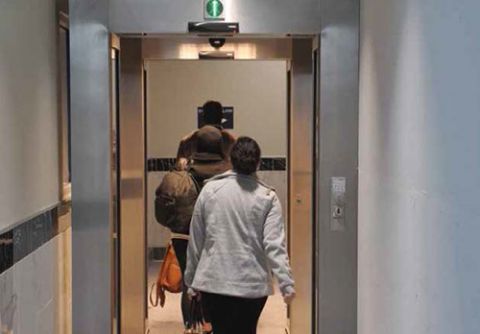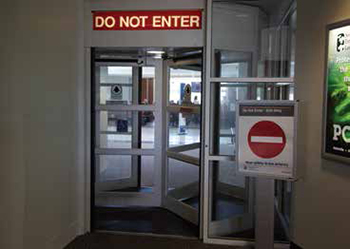Airports Boost Security & Reduce Operating Expenses With Automated Exit Lanes

From Oregon to Virginia, U.S. airports are slowly embracing the idea of replacing human guards with automated systems to prevent and detect exit-lane breaches. Those who have made the switch report that automated systems improve landside-to-airside security and reduce ongoing operating expenses.
TSA officials have been nudging airports toward automated exit lane security ever since the agency completed an evaluation of the technology roughly two years ago. After determining that automated systems are effective against wrong-way security breaches, TSA announced that it could opt to not staff exit lanes in new or recently remodeled terminals.
 facts&figures facts&figuresProject: Automated Exit Lane Security Location: Charlottesville (VA) Albermarle; Eugene (OR) Airports Main Components: Glass-walled security corridors; automatic doors operated by programmable sensors Key Benefits: Detect & reduce landside-to-airside security breaches; tighten security by eliminating human error; reduce operating costs System Providers: Kaba Access & Data Systems Americas; record-usa Architecture/Engineering at Charlottesville Albermarle Airport: Gresham & Partners Funding: Airport Improvement Program funds; passenger facility charges |
Currently, airport operators assuming responsibility for exit lane security have three options: airport-employed guards, private security firms or automated technology. Companies offering products for the third option include record-usa and Kaba Access and Data Systems Americas.
"When airports are tasked with the job of guarding the exit lane, they're leaning toward automated control," reports David Wurtz, Kaba's director of business development, PAS Americas. "It's a more cost-effective means of guarding an exit lane, plus it gives airports a very fast return on their investment and a higher level of security."
Wurtz is confident that when it comes to routine exit lane security, automation is the answer.
"Guards can be distracted or threatened; machines cannot," he explains. "(Machines) are impartial - they respond and react according to how they're programmed to stop somebody from coming through. Moreover, they allow airports to reallocate manpower ... take those people sitting in chairs and watching the exit lane and use them for, say, cargo or employee screening or checkpoint screening - something more productive."
Enhancing Throughput
In Virginia, Charlottesville Albermarle Airport (CHO) replaced its 1990s-era unmanned revolving door with an exit lane security system from Kaba in 2014. The revolving door sufficed for years, but it made sense to relocate the exit lane and install automated security as part of an ongoing $5 million renovation project, says Executive Director Melinda Crawford.
"The revolving door worked fine for the number of passengers we served at the time," Crawford explains. "But we've seen 35% passenger growth in the last 10 years, to about half a million in 2014."
The popularity of pull-behind carry-on bags also played a role in the decision. "When that door was installed, there wasn't a lot of wheeled luggage with long (telescoping) handles," she adds. "As handles became longer, we had more problems with luggage getting jammed in the door."
Whenever that happened, passengers had to wait for nearby airport personnel to extricate the luggage and reset the system. Eventually, CHO had to station an employee near the door at all times, she notes.
In addition, no formal exit lane existed for passengers. Instead, passengers snaked their way through lines of other passengers waiting at a cramped TSA security checkpoint or in the baggage claim area. "That created a lot of confusion for passengers, especially when the lines were long," Crawford recalls.
 The terminal reconfiguration successfully resolved the bottlenecks, she reports. To automate its exit lane security, CHO opted for a single-lane breach-control corridor that measures 20 feet long, about 5 feet wide and 9 feet tall. The new exit lane includes glass walls, a pair of swinging glass doors at each end, a ceiling and a half-height gate barrier on the landside.
The terminal reconfiguration successfully resolved the bottlenecks, she reports. To automate its exit lane security, CHO opted for a single-lane breach-control corridor that measures 20 feet long, about 5 feet wide and 9 feet tall. The new exit lane includes glass walls, a pair of swinging glass doors at each end, a ceiling and a half-height gate barrier on the landside.
The new exit lane, as reconfigured by Gresham, Smith & Partners, also features a "throat" that funnels passengers toward a wall that then steers them to the right, into the adjacent baggage claim area. The new system discourages overly eager meeters and greeters from breaching security by running into the exit lane to welcome arriving passengers, Crawford points out.
Wilson Rayfield, a Gresham, Smith & Partners architect for the CHO project, notes that replacing the airport's low-capacity revolving door with an automated exit lane improved throughput and security while opening up the space for a complete overhaul of the checkpoint.
 "If we had implemented a traditional exit lane to replace the revolving door, the airport would need extra staff to monitor it and prevent passenger backflow," explains Rayfield.
"If we had implemented a traditional exit lane to replace the revolving door, the airport would need extra staff to monitor it and prevent passenger backflow," explains Rayfield.
For CHO, assuming the one-time capital cost of an automated system made more sense than hiring four to six security guards, which would entail ongoing operational expenses. "As a smaller airport, we're very mindful of both present and future costs," Crawford comments. "Because our airlines are our partners, we try to keep costs as low as we can to minimize increases in airline and user fees. Everything we did on this project focused on cost-saving elements if we could find them."
Crawford also acknowledges the reliability of automation: "When you have a human element, you bring another level of inefficiency to security because it's manned and subject to mistakes."
 Adjustable Automation
Adjustable Automation
Eugene Airport (EUG) is beginning the new year with a new strategy for exit lane security. The Oregon airport incorporated the installation of automated lane equipment by record-usa into its recent $17 million terminal expansion project.
Previously, TSA guards and private security personnel hired by the airport monitored the exit lane. "We've wanted some kind of technology solution to our exit lane for quite some time," reflects Assistant Airport Director Cathryn Stephens. "And the terminal expansion provided an opportunity to do it."
The expansion project included relocating the TSA screening checkpoint to a gatehold room and creating space for the new exit lane system. "The terminal was never designed to accommodate a full screening security facility, so it became constrained as passengers increased," says Stephens, noting that the airport has enjoyed five consecutive years of record enplanements. Passenger volume at EUG increased 20% during the last four years, and she expects about a total of about 900,000 passengers in 2015.
 Passenger facility charge revenue was used to purchase the exit lane system. "It'll pay for itself in about three years through reduced security costs," she adds.
Passenger facility charge revenue was used to purchase the exit lane system. "It'll pay for itself in about three years through reduced security costs," she adds.
The new exit lane is comprised of two side-by-side corridors, each with two automatic doors and an exit swing gate. The footprint of each module is about 171/2 feet long, 8 feet tall and 5 feet wide. "We wanted two lanes for more efficient movement of passengers," Stephens explains.
Airport personnel can select one of three different operating modes. Flow mode keeps all the doors open during high-traffic periods to maximize passenger throughput. When the system in is interlock/low-traffic mode, the entry door closes after a passenger enters the corridor, and the next door will not open until the first one closes. Flow-to-interlock mode combines both modes to handle sudden surges of passengers during low-traffic periods.
 The annual cost of hiring private security guards heavily influenced EUG officials' decision to install an automated system. In fiscal year 2014, the airport paid nearly $50,000 to a private security service that secured the exit lane for about 39 hours a week, Stephens reports.
The annual cost of hiring private security guards heavily influenced EUG officials' decision to install an automated system. In fiscal year 2014, the airport paid nearly $50,000 to a private security service that secured the exit lane for about 39 hours a week, Stephens reports.
High-Tech Methods
The record-usa system relies on sensors that detect wrong-way movement in the exit lane corridor - passengers moving from landside to airside, that is.
During "normal operations," sensors automatically open the system's entry door when they detect the presence of a passenger, and then close it behind the passenger. The same sequence is then repeated at the end of the corridor.
 If airport visitors try to enter the system from the landside, a sensor detects the breach and sets off an alarm. Additionally, an automated voice informs them that are going the wrong way and instructs them to turn around and go back. "The voice module can be customized to say whatever the airport wants it to say," notes Bill Seibert, sales manager of Airports and Healthcare for record-usa.
If airport visitors try to enter the system from the landside, a sensor detects the breach and sets off an alarm. Additionally, an automated voice informs them that are going the wrong way and instructs them to turn around and go back. "The voice module can be customized to say whatever the airport wants it to say," notes Bill Seibert, sales manager of Airports and Healthcare for record-usa.
The Kaba system relies on video-analytic detection technology that captures real-time video images. An algorithm-based software system analyzes images and decides whether to sound an alarm based on a given airport's security protocols. "In effect, it takes video of what's going on and sends it through analytic software that analyzes each frame and compares them to a known secure condition," Wurtz explains. "The system knows what it's supposed to look like when things are secure."
Both systems also include object detectors that sense when items such as purses or carry-on bags are left behind. "If a passenger is walking through and accidentally or purposely drops something, sensors detect it and send an alarm to the airport, notifying them that something is inside the tunnel," says Seibert. "The floor detection covers the corridor from corner to corner and can detect objects as small as 2 inches by 2 inches by 2 inches. The system also can detect if something is placed on the walls or the ceiling."
The return on investment for such systems varies from airport to airport, depending on many variables - not the least of which is the size and scope of remodeling required to accommodate a new exit lane. Wurtz reports that the breakeven period for a single-lane system, without construction costs, can be as short as 12 to 18 months. Naturally, the timetable depends on how much an airport previously paid for security guards. "In either case, there's a quantifiable return on investment," he adds.
Trend Toward Automation
While automated exit lanes are not widely used now, Seibert and Wurtz anticipate demand to increase in the wake of TSA's decision to ease out of the exit-lane-monitoring business. Kaba has installed a three-lane and a single-lane system at McCarran International Airport (LAS) in Las Vegas. Personnel from record-usa report has six North American installations completed and three more scheduled.
The bottom line? "It's always on, and always alert," Seibert says. "It removes the human-error factor."
Crawford reports that she and other officials at CHO are very happy with their automated system, which was installed last October (2015). It helped immensely for staff members to meet with maintenance staff at LAS to discuss their experience with the system, she adds.
"If your airport is considering an automated system, you should explore all the technology available and visit other airports to see how it works there to determine what's best suited for your facility," Crawford suggests. "After all, it's not something you're going to do every year, so it's imperative to plan well and do it right."
Ultimately, she considers exit lane infrastructure a service issue: "Customers deserve the best improvements we can make that are focused on better service. Yes, construction does create chaos. But at the end of the day, it's worth all the pain and effort."
For more information about automated exit lanes, visit AirportImprovement.com. Installations at Seattle-Tacoma International Airport and Portland International Jetport were featured in the November/December 2013 issue.
FREE Whitepaper
Fairbanks International Airport Baggage Transport Conveyor Enhanced With Mod Drive™ System
Airports face a host of unique industry challenges, such as meeting efficiency regulations and seeking out the best maintenance practices to reduce costs and keep operations flowing. In today’s current economic climate, any potential cost savings can go a long way.
In 2019, Alaska’s Fairbanks International Airport (FAI) sought to modernize its equipment and operations. They were dissatisfied with the performance of the gearmotors on their baggage transport conveyors and began searching for new suppliers. Regal approached FAI with a solution that could improve equipment performance and simplify maintenance, with the added benefit of energy cost savings: the Hub City® MOD Drive™ system.
This white paper discusses the hardware deployed, the test results and the annualized expectations for ROI.








